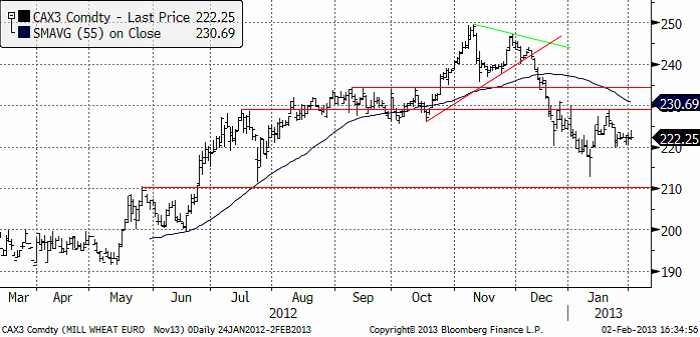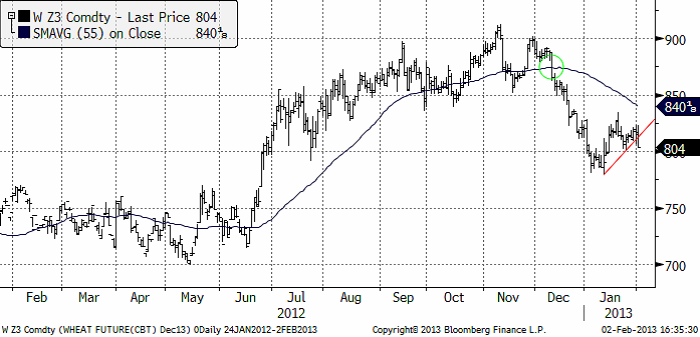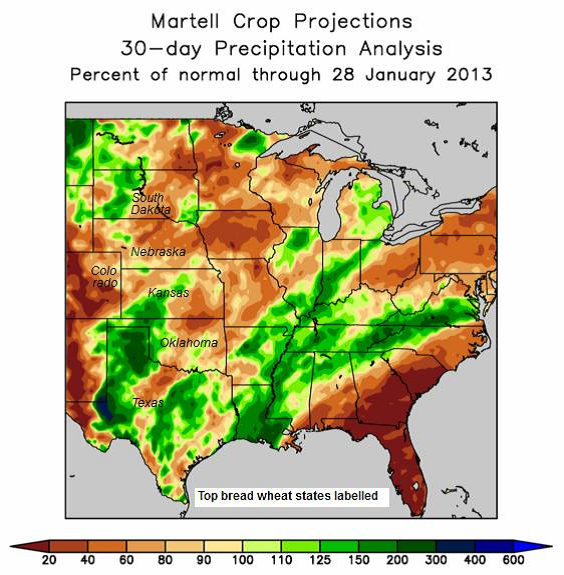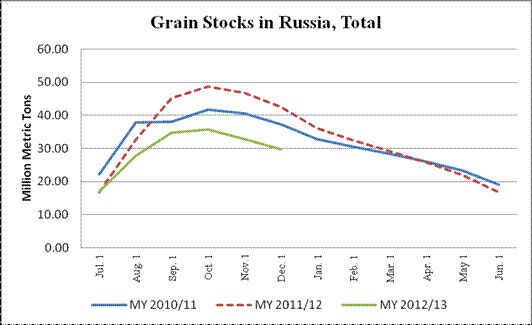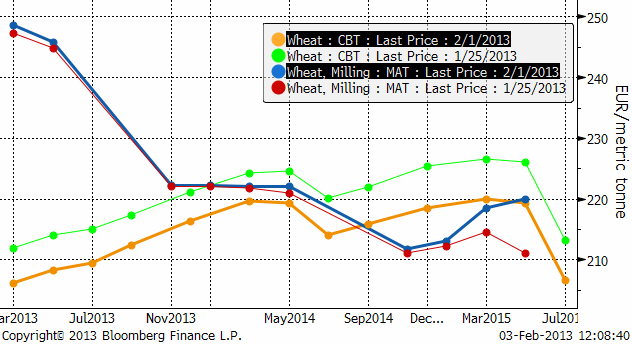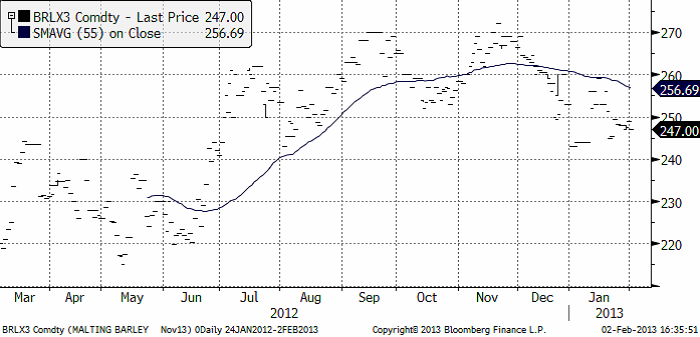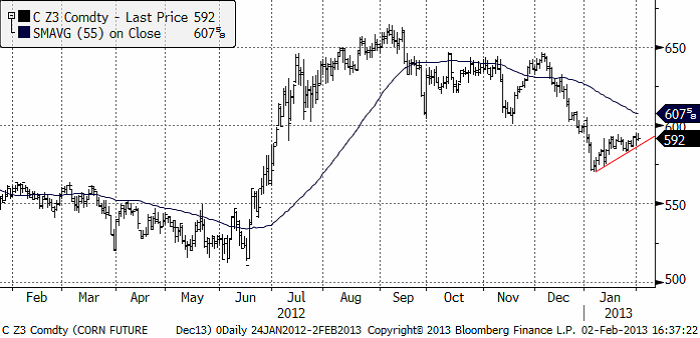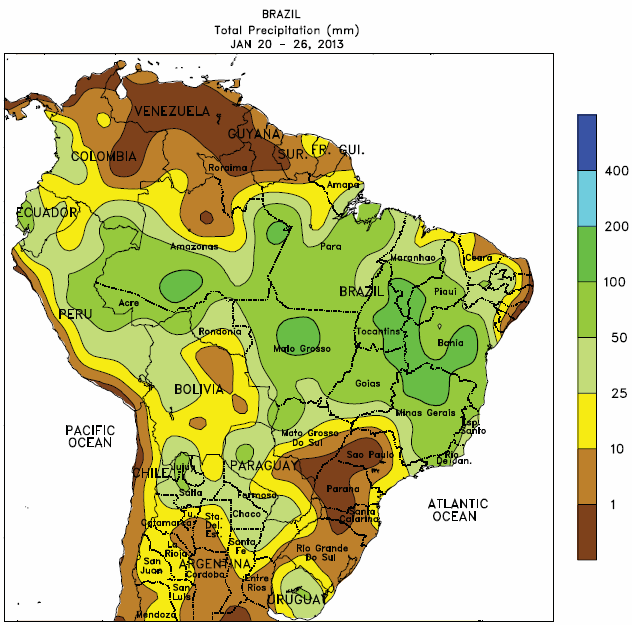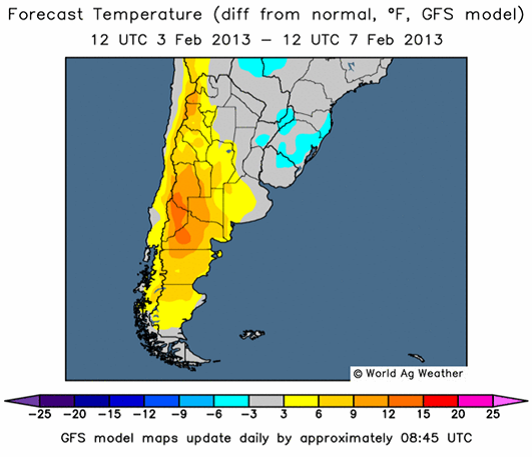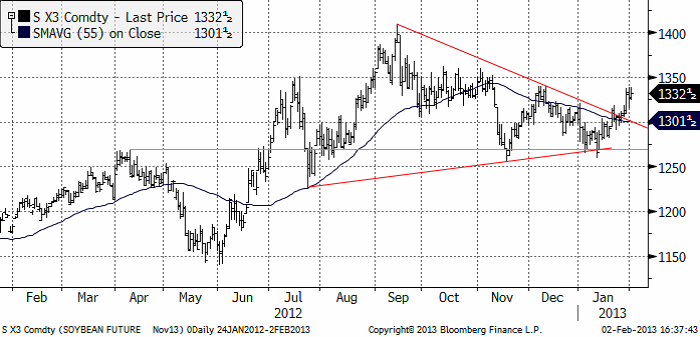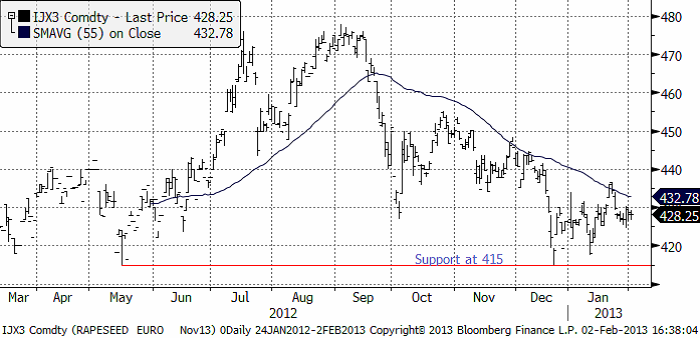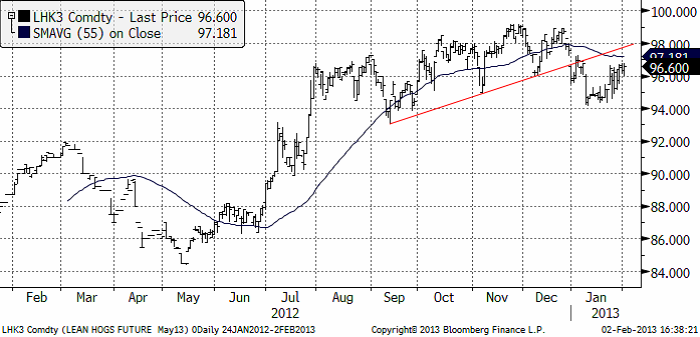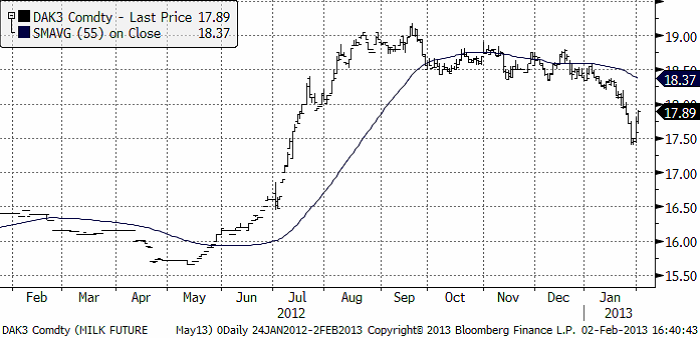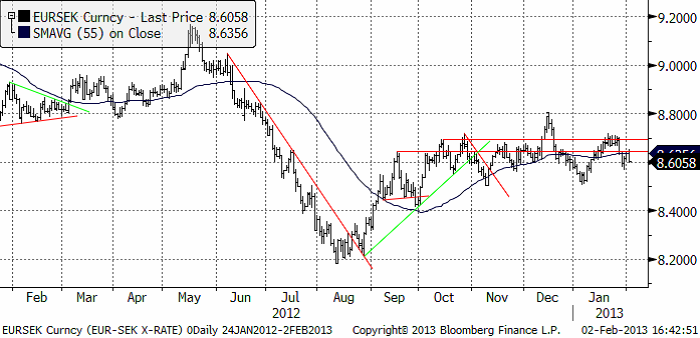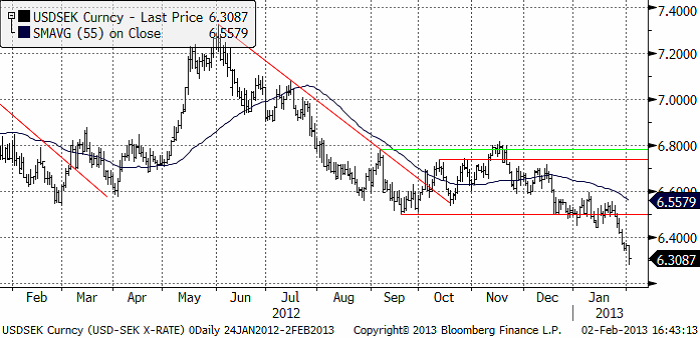Analys
SEB Jordbruksprodukter, 4 februari 2013

 Prisförändringarna på terminsmarknaderna för jordbruksprodukter var marginella förra veckan. Vetepriserna var i princip oförändrade. Sojabönorna handlades upp ett par tre procent på de första indikationerna att hektarskörden i Brasilien är lite sämre än väntat. Rapspriserna på Matif påverkades dock inte. I motsatt riktning – och den andra råvaran som rörde sig prismässigt över huvud taget var mjölk. Priserna på smör och mjölk på Eurex sjönk med ett par procent – och följer därmed efter det tidigare prisfallet på Class III – mjölk i USA.
Prisförändringarna på terminsmarknaderna för jordbruksprodukter var marginella förra veckan. Vetepriserna var i princip oförändrade. Sojabönorna handlades upp ett par tre procent på de första indikationerna att hektarskörden i Brasilien är lite sämre än väntat. Rapspriserna på Matif påverkades dock inte. I motsatt riktning – och den andra råvaran som rörde sig prismässigt över huvud taget var mjölk. Priserna på smör och mjölk på Eurex sjönk med ett par procent – och följer därmed efter det tidigare prisfallet på Class III – mjölk i USA.
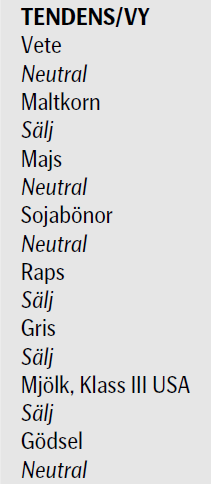 Den här veckan avslutas på fredag med den andra WASDE-rapporten i år. Klockan 18:00 släpper det amerikanska jordbruksdepartementet siffrorna. Vi återkommer senare under veckan med marknadens förväntningar inför den.
Den här veckan avslutas på fredag med den andra WASDE-rapporten i år. Klockan 18:00 släpper det amerikanska jordbruksdepartementet siffrorna. Vi återkommer senare under veckan med marknadens förväntningar inför den.
Odlingsväder
Europa fick snöfall som blev regn i södra Europa. Den västra delen av Ryssland och Ukraina fick milt väder, som gjorde att det skyddande snötäcket smälte på sina håll. Sydostasien fick riklig monsunnederbörd, som är bra för risproduktionen. Argentina fortsatte att vara torrt. Det ger en snabbare mognad, men riskerar också att ge en mindre skörd. Brasilien i söder berörs av samma torra väder som i norra Argentina. Längre uppåt landet föll god nederbörd.
Torkan i USA ligger kvar på nästan exakt samma höga nivå som varit rådande sedan början av december.
 Vi fick ett mail från den amerikanska börsen CME, där CBOT ingår, om att de troligtvis kommer att reducera sina öppettider för handel med spannmål / oljeväxter som ett svar på synpunkter från branschen. Börsen, som just nu håller på med en undersökning bland sina kunder gällande öppettiderna, säger att även om inte undersökningen är komplett så har de redan fått tillräckligt med svar för att reducera öppettiderna för handel med terminer på spannmål och sojabönor, och avvaktar nu godkännande från CFTC.
Vi fick ett mail från den amerikanska börsen CME, där CBOT ingår, om att de troligtvis kommer att reducera sina öppettider för handel med spannmål / oljeväxter som ett svar på synpunkter från branschen. Börsen, som just nu håller på med en undersökning bland sina kunder gällande öppettiderna, säger att även om inte undersökningen är komplett så har de redan fått tillräckligt med svar för att reducera öppettiderna för handel med terminer på spannmål och sojabönor, och avvaktar nu godkännande från CFTC.
En reducering av öppettiderna skulle delvis vara en återgång av CME:s kontroversiella beslut under 2012 att utöka öppettiderna. Börsen säger samtidigt att det finns flera olika uppfattningar om när marknaden ska vara öppen framöver och att de därför återkommer med fler detaljer under de kommande veckorna.
CME säger också att de är öppna för att överväga stopp av handeln under publiceringen av USDA:s viktigaste rapporter (bl.a WASDE) månadsvis och kvartalsvis. Konkurrenten ICE, vars lansering av terminskontrakt för spannmål och oljeväxter fick CME att utöka sina öppettider, har dock inga planer på att göra några förändringar av sina öppettider.
Vete
Priset på november (2013) kontraktet stabiliserade sig stödet vid 220 euro i veckan.
Nedan ser vi decemberkontraktet på CBOT, där det tekniska stödet bröts sent på fredagseftermiddagen. Detta signalerar prisfall, men 800 cent / bu är å andra sidan ett psykologiskt motstånd. Hela den tekniska bilden talar dock för lägre priser.
Efter de senaste dagarna med gatuvåld och månader av politisk oro gick Egyptens försvarsminister ut med den kraftiga varningen att ”en fortsättning av konflikten mellan de olika politiska krafterna och deras olikheter över hur landet ska styras kan leda till att staten kollapsar och därmed hota framtida generationer”. Egypten står inför en allt större ekonomisk och politisk instabilitet, där det egyptiska pundet har förlorat mer än en tiondel av sitt värde sedan revolutionen 2011. Många egyptier är beroende av det subventionerade bröd som säljs för ca 0.05 kr och störningar av brödutbudet skulle kunna leda till ytterligare oroligheter. Egyptens GASC har under januari månad köpt 115 000 ton vete för leverans 20-28 februari, vilket endast är hälften så mycket som under januari 2012. Fortsatta oroligheter kan leda till svårigheter att finansiera inköp av vete, men enligt GASC så har man vare sig finansiella problem och dessutom lager fram till mitten/slutet på juni, något som dock ifrågasätts om det verkligen stämmer.
Sådden av vete i Kanada, kan förmodligen komma att stiga med så mycket som 10 procent som en följd av ökad areal och höga priser enligt CWB (Canadian Wheat Board). Arealen kan komma att öka med 5-10 procent jämfört med förra årets 9.63 miljoner hektar, då lantbrukare skiftar till vete från andra mindre lönsamma grödor som t.ex oljeväxter och råg. Förra årets sådd av vårvete uppgick till 6.85 miljoner hektar, vilket motsvarar 71 procent av den totala vetearealen, inklusive höstgrödorna och durumvete. Den totala skörden av samtliga vetesorter uppgick till 27.2 mt under 2012/13.
Enligt AgCanada kan den kanadensiska produktionen av vete, inklusive durum, 2013/14 komma att öka med 4.8 procent till 28.5 mt, tack vare ökad areal. I veckan publicerades årets första gissning om arealen för årets veteproduktion. 25.3 miljoner acres är 1.5 mA mer än förra året.
Trots ökad nederbörd under januari månad över sydvästra Kansas, västra Oklahoma och delar av Texas, så visar USDA’s senaste rapport att tillståndet för det amerikanska vetet har förvärrats. Tillståndet för vete i Kansas, den största producenten av höstgrödan, har justerats ned från månaden innan då den värsta torkan i USA sedan 1930-talet kvarstår. 20 procent av grödan klassas nu som ”good/excellent”, där endast 1 procent tillhör ”excellent”, jämfört med 24 procent i slutet av december. 39 procent klassas som ”poor/very poor” jämfört med 35 procent månaden innan. I den sista rikstäckande rapporten som USDA skickade ut i slutet på november var 29 procent av höstvetet klassat som ”good/excellent”, vilket är den lägsta nivån sedan åtminstone 1985 då man började föra register. Än värre är det i Oklahoma, den näst största producenten, där endast 5 procent är klassat som ”good” (11 procent månaden innan) medan ”poor/very poor” uppgår till höga 69 procent.
I Nebraska klassas 8 procent som ”good/excellent” och 50 procent som ”poor/very poor”, medan i South Dakota tillhör 3 procent ”good/excellent” medan 66 procent är klassat som ”poor/very poor”.
Argentina har i princip sålt sitt vete (det mesta till Brasilien).
I EU var det en vecka tunn på exportsidan. I Ryssland rapporterades vetelagren uppgå till 13 mt vid årsskiftet. Det är 40% mindre än förra året. Det innebär att Ryssland når botten på lagren i slutet av april.
Enligt den fristående analytikern Noel Fryer är Rysslands importbehov samtalsämnet för dagen i Svartahavsområdet. I fredags hölls ett möte i Moskva om att eventuellt ta bort importtullen om 5% på vete, men inget kom ut av det. Ett nytt möte ska hållas nästa vecka där Medvedev ska vara ordförande.
De inhemska spannmålspriserna i Ryssland har fortsatt att stiga som en följd av markant lägre lager pga av en mindre skörd i kombinationen med en stark export i början av säsongen. Enligt Rosstat uppgick Rysslands totala skörd av spannmål och baljväxter till 70.7 mt jämfört med 94.2 mt året innan, varav 37.7 mt vete och 8 mt majs. Skörden av vete är därmed den lägsta på ett decennium, medan skörden av majs är rekordhög.
Det inhemska priset på kvarnvete i Ryssland steg till nya rekordnivåer under förra veckan, över 2008 års priser. I diagrammet nedan ser vi de totala spannmålslagren i Ryssland.
Rysslands export av spannmål 2012/13 estimeras till 14.8 mt, och de har redan exporterat 13.5 mt spannmål den här säsongen inklusive 10 mt vete. Importen av spannmål förväntas uppgå till 1.2 mt och under perioden juli-december har landet importerat 486 000 ton, varav merparten från Kazakstan. För 2013/14 förväntas produktionen att uppgå till 95 mt, vilket skulle generera ett överskott till export på 15 mt.
GASC har samtidigt, som nämnt ovan, sagt att de har fulla lager, vilket är anledningen till att de inte köpte så mycket i den senaste tendern. Däremot sade de att de har finanserna i ordning för att köpa mer när de behöver. Det kan alltså bli konkurrens om vetet framåt våren.
Vi ser att detta återspeglade sig i rörelsen i terminskurvan, som gick ännu mer in i backwardation på Matif. De korta kontrakten mars och maj för gammal skörd steg, medan november (ny skörd) inte förändrades alls mellan fredagen den 25 januari och den 1 februari.
I diagrammet ovan ser vi också tydligt att hela terminskurvan för Chicagovete föll ganska kraftigt. Ingen mannamån alls. De längre kontrakten något mer i pris, i synnerhet för leverans av 2014 års skörd.
Vi fortsätter vår neutrala vy på vetet. Tekniskt lutar det åt lägre pris. Den fundamentala informationen förebådar tilltagande oro på vetemarknaden i vår och torkan i USA ser inte ut att lätta.
Maltkorn
I diagrammet ovan ser vi också tydligt att hela terminskurvan för Chicagovete föll ganska kraftigt. Ingen mannamån alls. De längre kontrakten något mer i pris, i synnerhet för leverans av 2014 års skörd. Vi fortsätter vår neutrala vy på vetet. Tekniskt lutar det åt lägre pris. Den fundamentala informationen förebådar tilltagande oro på vetemarknaden i vår och torkan i USA ser inte ut att lätta.
November 2013-kontraktet sjönk för andra veckan i rad, från 248.25 till 247 euro per ton.
Majs
Majspriset (december 2013) fortsatte sin rekyl uppåt, men slutade veckan med prisnedgångar. Priset ligger fortsatte för andra veckan att glida uppåt precis dikt an det tekniska stödet. När nu rekylen tagit priset upp till strax under den jämna siffran 600 cent, ”borde” uppgången ta slut. Stödet ”borde” brytas och priset falla ner till åtminstone 575 cent i första hand och 550 cent i andra hand.
Veckovis etanolproduktion i USA sjönk till en rekordlåg nivå 700 fat per dag, som vi ser i diagrammet nedan. Det är den lägsta produktionsnivån sedan DOE började publicera produktionsstatistiken varje vecka. Den senaste noteringen är för veckan som slutade fredagen den 25 januari.
Det höga priset på majs sköter alltså sitt ransoneringsjobb ganska bra när det gäller majs. Etanol är inte livsviktigt heller, till skillnad från vete, t ex. En rekordskörd väntas i USA. WASDE-rapporten på fredag kommer kanske att kasta än mer ljus över utbuds- och efterfråge-ekvationerna. Mer klarhet kan säkerligen få marknadens oro att dämpa sig.
Enligt BAGE är Argentinas sådd av majs klar till 98.7 procent, jämfört med 96.4 procent förra veckan. Pablo Adreani, AgriPac Consultores, säger att han kan komma att justera ned sitt estimat för Argentinas majs produktion 2012/13 till 25.5 mt, jämfört med tidigare estimat om 27.1 mt.
I Brasilien sås nu den andra skörden ”safrinha”. Skörden väntas till sommaren. Cordonnier’s estimat för Brasiliens produktion av majs 2012/13 är oförändrad från tidigare estimat på 70 mt, och även Argentinas majsproduktion 2012/13 är oförändrat på 22.5 mt. El Tejar Ltd uppskattar Argentinas produktion av majs till 24-25 mt.
Vi fortsätter att ha en neutral vy på majs. Skulle det tekniska stödet i diagrammet för december-majs brytas vill vi sälja.
Sojabönor
Sojabönorna (november 2013) fortsatte upp, efter att förra veckan ha brutit motståndslinjen i kursdiagrammet, som vi skrev om förra veckan. Regnen i Brasilien, där skörden inletts, försämrar transportmöjligheterna. De första rapporterna visar också att hektarskörden är något lägre än väntat av CONAB med flera. Dessa nyheter gav understöd till veckans prisuppgång. I Argentina är skörden till 8% klar, vilket är långt efter det normala. BAGE rapporterade att torkan ”börjar påverka hektarskörden negativt”. I kartbilden nedan ser vi nederbörden i Brasilien förrförra veckan. Vi ser att det saknas nederbörd i den södra delen av kartbilden, ner mot Argentina. Vi ser också att mitt i det viktiga sojadistriktet i Mato Grosso är det extra mycket nederbörd.
USDA’s FAS uppskattade produktionen i Argentina till 54 mt per den 23 januari och samma dag kom Rosario Grain Exchange med sin prognos på 53 mt. Rapporter säger att förra månaden kan ha varit den varmaste januari sedan 1957, och temperaturen förväntas uppgå till mer än 40 grader med spridda skurar under nästa vecka. För veckan 7-13 februari förväntas temperaturen att överstiga 35 grader.
Enligt BAGE är Argentinas sådd av sojabönor klar till 99.4 procent, en ökning med 2 procent sedan förra veckan. Pablo Adreani, AgriPac Consultores, säger att hans prognos för Argentinas produktion av sojabönor kan komma att justeras ned till 48.5 mt (mot tidigare 51.3 mt) om landet inte får tillräckligt med nederbörd.
Cordonniers estimat för Brasiliens produktion av sojabönor 2012/13 är oförändrad från tidigare estimat på 81 mt, medan Argentinas sojabönsproduktion 2012/13 justeras ned med 1 mt till 52.0 mt.
El Tejar Ltd estimerar Brasiliens produktion av sojabönor 2012/13 till 80-81 mt, jämfört med CONAB’s estimat på 82.7 mt. Argentinas produktion av sojabönor 2012/13 estimeras till 50.0 mt, medan Paraguays beräknas uppgå till 8.0 mt.
Enligt IMEA (Instituto Mato-Grossense de Economia Agropecuária) är skörden av sojabönor i brasilianska Mato Grosso avklarad till 7 procent jämfört med 3 procent för en vecka sedan. Nedanför ser vi kurdiagrammet för sojabönor (november 2013).
Prisuppgången borde stöta på motstånd i form av vinsthemtagningar / lantbrukares säljordrar vid 1350 cent / bushel. Det är en jämn och fin siffra och tidigare uppgångar från juli och senare har hejdats vi den nivån.
Vi fortsätter att ha en neutral vy i det här veckobrevet. Det troligaste just nu anser vi är att prisuppgången hejdas i veckan som kommer. WASDE-rapporten ger sedan ny vägledning för marknaden. Tekniskt ser det ut som om priset skulle kunna backa något på vinsthemtagningar.
Raps
Rapspriset (november 2013) rörde sig knappast alls i veckan som gick. Vi fortsätter att tolka marknadens beteende som en rekyl i en sjunkande marknad, alternativt som en konsolideringsfas, som kanske kan sluta i att marknaden stiger – men inte än.
Som vi skrev om tidigare i brevet så skiftar lantbrukare i Kanada från t.ex oljeväxter till vete pga högre priser och enligt Oil World så förväntas kanadensiska lantbrukare att minska sin sådd av raps (canola) med 10 procent till förmån för vete. Sådden av canola beräknas uppgå till 7.7 miljoner hektar, en minskning från förra årets rekordhöga 8.61 miljoner hektar, som en följd av låg avkastning, problem med sjukdomar på grund av brist på växelbruk, ökad sådd av sojabönor och som tidigare nämnts, högre priser på vete.
AgCanada höjer sin prognos för den kanadensiska canola produktionen 2013/14 till 15.5 mt från de 13.3 mt som producerades 2012/13. Vi fortsätter att ha en övervägande negativ vy på prisutvecklingen på raps.
Gris
Grispriset (Maj 13), amerikansk Lean Hogs, har rekylerat uppåt efter brottet nedåt av stödlinjen vid årsskiftet. Rekylen uppåt följer ett klassiskt mönster. Den är ett säljtillfälle.
Mjölk
I diagrammet nedan ser vi tre kurvor. Den gröna linjen är priset på smör i euro per ton på Eurex-börsen. Den svarta är priset på smp på Eurex börsen. Priserna på Eurex anges i euro per ton.
Slutligen så den rosa linjen. Den visar priset på helmjölkspulver (WMP) FOB Västeuropa. Källan är USDA och priserna uppdateras varannan vecka. Vi ser att WMP-priset legat stabilt det fjärde kvartalet förra året.
Såväl smör som SMP har haft en påfallande svag prisutveckling, vilket kan vara början på ett en större prisjustering nedåt. Möjligen har marknaden tagit intryck av prisfallet i terminerna (maj 2013) på Klass 3 – mjölk, som vi ser i diagrammet nedan. Vi har noterat att de amerikanska terminsmarknaderna tycks ”leda” utvecklingen i Europa. I USA hejdades dock prisfallet i veckan som gick, som vi ser i diagrammet nedan.
På tisdag, den 5 februari klockan 18:00 publiceras resultaten från Fonterras auktion av mjölkpulver. På basis av prisfallet i USA, ”borde” priset på SMP och smör på Eurex justeras ner i veckan som kommer.
EURSEK
EURSEK föll i veckan som gick. Motståndet blev för starkt. Det är tystare om EU:s kris nu. Nyhetsbevakningen har haft andra fokus i veckan.
USDSEK
Dollarn har fortsatt att utveckla sig svagt mot kronan. Trenden fortsätter. Skuldkrisen hanterades i veckan – genom att skuldtaket höjdes i ett politiskt beslut. Frågan är om talesättet ”the sky is the limit” är aktuellt. Fortroendet för USA:s förmåga att lösa problemet fick sig en törn i veckan och dollarn fick lida för det.
[box]SEB Veckobrev Jordbruksprodukter är producerat av SEB Merchant Banking och publiceras i samarbete och med tillstånd på Råvarumarknaden.se[/box]
Disclaimer
The information in this document has been compiled by SEB Merchant Banking, a division within Skandinaviska Enskilda Banken AB (publ) (“SEB”).
Opinions contained in this report represent the bank’s present opinion only and are subject to change without notice. All information contained in this report has been compiled in good faith from sources believed to be reliable. However, no representation or warranty, expressed or implied, is made with respect to the completeness or accuracy of its contents and the information is not to be relied upon as authoritative. Anyone considering taking actions based upon the content of this document is urged to base his or her investment decisions upon such investigations as he or she deems necessary. This document is being provided as information only, and no specific actions are being solicited as a result of it; to the extent permitted by law, no liability whatsoever is accepted for any direct or consequential loss arising from use of this document or its contents.
About SEB
SEB is a public company incorporated in Stockholm, Sweden, with limited liability. It is a participant at major Nordic and other European Regulated Markets and Multilateral Trading Facilities (as well as some non-European equivalent markets) for trading in financial instruments, such as markets operated by NASDAQ OMX, NYSE Euronext, London Stock Exchange, Deutsche Börse, Swiss Exchanges, Turquoise and Chi-X. SEB is authorized and regulated by Finansinspektionen in Sweden; it is authorized and subject to limited regulation by the Financial Services Authority for the conduct of designated investment business in the UK, and is subject to the provisions of relevant regulators in all other jurisdictions where SEB conducts operations. SEB Merchant Banking. All rights reserved.
Analys
Brent crude inching higher on optimism that US inflationary pressures are fading


Brent crude price inching higher on optimistic that US inflationary pressures are fading. Brent crude closed up 1.1 USD/b ydy to a close of USD 86.39/b which was the highest close since the end of April. This morning it is trading up another half percent to USD 86.9/b along with comparable gains in industrial metals and Asian equities. At 14:30 CET the US will publish its preferred inflation gauge, the PCE figure. Recent data showed softer US personal spending in Q1. Expectations are now high that the PCE inflation number for May will show fading inflationary pressures in the US economy thus lifting the probability for rate cuts later this year which of course is positive for the economy and markets in general and thus positive for oil demand and oil prices. Hopes are high for sure.
Brent crude is trading at the highest since the end of April
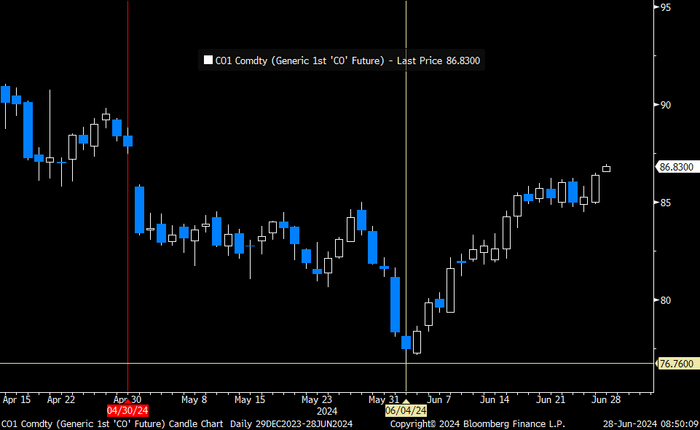
The rally in Brent crude since early June is counter to rising US oil inventories and as such a bit puzzling to the market.
US commercial crude and oil product stocks excluding SPR.
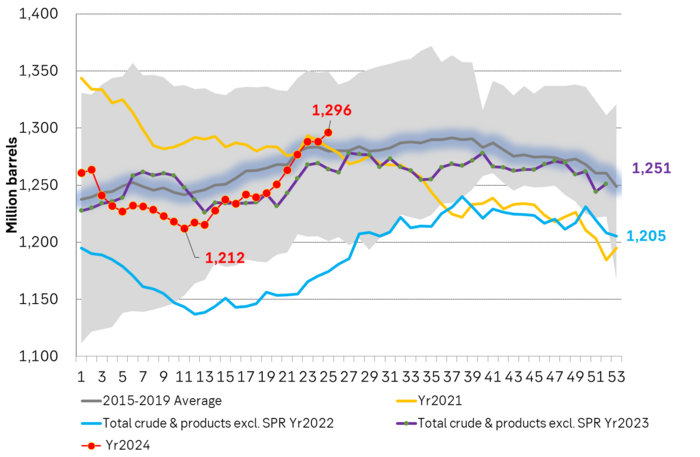
Actual US crude oil production data for April will be published later today. Zero growth in April is likely. Later today the US EIA will publish actual production data for US crude and liquids production for April. Estimates based on US DPR and DUC data indicates that there will indeed be zero growth in US crude oil production MoM in April. This will likely driving home the message that there is no growth in US crude oil production despite a Brent crude oil price of USD 83/b over the past 12 mths. The extension of this is of course rising expectations that there will be no growth in US crude oil production for the coming 12 months either as long as Brent crude hoovers around USD 85/b.
US production breaking a pattern since Jan 2014. No growth at USD 83/b. What stands out when graphing crude oil prices versus growth/decline in US crude oil production is that since January 2014 we have not seen a single month that US crude oil production is steady state or declining when the Brent crude oil price has been averaging USD 70.5/b or higher.
US Senate looking into the possibility that US shale oil producers are now colluding by holding back on investments, thus helping to keep prices leveled around USD 85/b.
Brent crude 12mth rolling average price vs 4mth/4mth change in US crude oil production. Scatter plot of data starting Jan 2014. Large red dot is if there is no change in US crude oil production from March to April. Orange dots are data since Jan 2023. The dot with ”-1.3%” is the March data point.
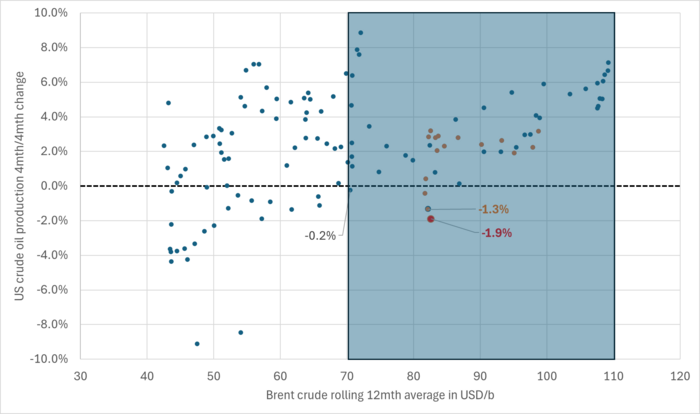
Brent crude 12mth rolling average price vs 4mth/4mth change in US crude oil production. Data starting Jan 2014. The last data point is if there is no change in US crude oil production from March to April.
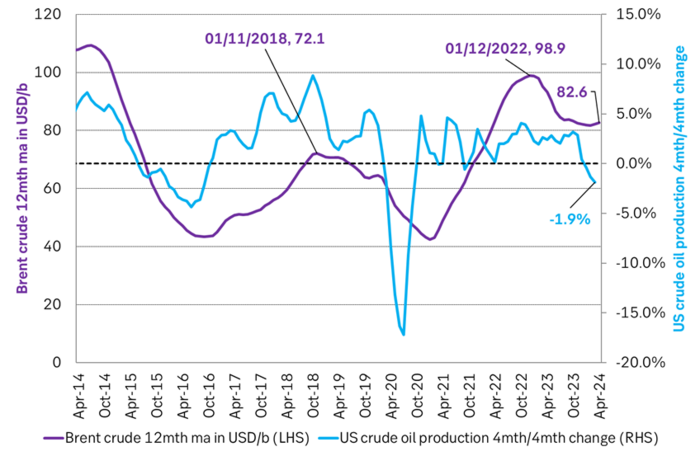
Analys
Price forecast update: Weaker green forces in the EU Parliament implies softer EUA prices


We reduce our forecast for EUA prices to 2030 by 10% to reflect the weakened green political agenda in the EU Parliament following the election for the Parliament on 6-9 June. The upcoming election in France on 7 July is an additional risk to the political stability of EU and thus in part also to the solidity of the blocks green agenda. Environmental targets for 2035 and 2040 are most at risk of being weakened on the margin. EUA prices for the coming years to 2030 relate to post-2030 EUA prices through the bankability mechanism. Lower post-2030 climate ambitions and lower post-2030 EUA prices thus have a bearish impact on EUA prices running up to 2030. Actual softening of post-2030 climate ambitions by the EU Parliament have yet to materialize. But when/if they do, a more specific analysis for the consequences for prices can be carried out.
EUA prices broke with its relationship with nat gas prices following the EU Parliament election. The EUA price has dutifully followed the TTF nat gas price higher since they both bottomed out on 23 Feb this year. The EUA front-month price bottomed out with a closing price of EUR 50.63/ton on 23 Feb. It then reached a recent peak of EUR 74.66/ton on 21 May as nat gas prices spiked. Strong relationship between EUA prices and nat gas prices all the way. Then came the EU Parliament election on 6-9 June. Since then the EUA price and TTF nat gas prices have started to depart. Bullish nat gas prices are no longer a simple predictor for bullish EUA prices.
The front-month EUA price vs the front-year TTF nat gas price. Hand in hand until the latest EU Parliament election. Then departing.
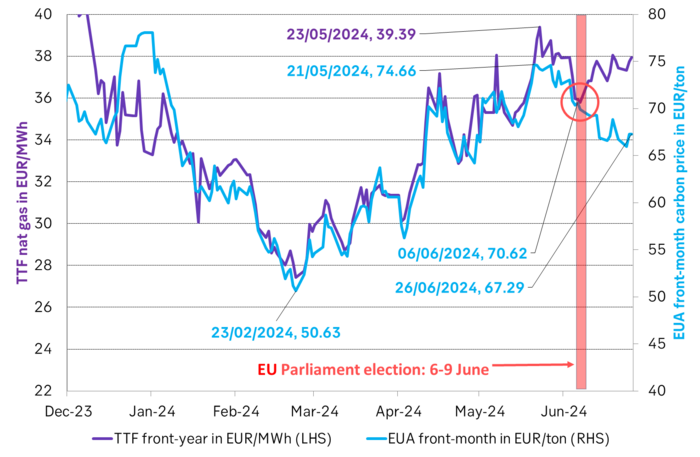
The EU Parliament election on 6-9 June was a big backlash for the Greens. The Greens experienced an euphoric victory in the 2019 election when they moved from 52 seats to 74 seats in the Parliament. Since then we have had an energy crisis with astronomic power and nat gas prices, rampant inflation and angry consumers being hurt by it all. In the recent election the Greens in the EU Parliament fell back to 53 seats. Close to where they were before 2019.
While green politics and CO2 prices may have gotten a lot of blame for the pain from energy prices over the latest 2-3 years, the explosion in nat gas prices are largely to blame. But German green policies to replace gas and oil heaters with heat pumps and new environmental regulations for EU farmers are also to blame for the recent pullback in green seats in the Parliament.
Green deal is still alive, but it may not be fully kicking any more. Existing Green laws may be hard to undo, but targets for 2035 and 2040 will be decided upon over the coming five years and will likely be weakened.
At heart the EU ETS system is a political system. As such the EUA price is a politically set price. It rests on the political consensus for environmental priorities on aggregate in EU.
The changes to the EU Parliament will likely weaken post-2030 environmental targets. The changes to the EU Parliament may not change the supply/demand balance for EUAs from now to 2030. But it will likely weaken post-2030 environmental targets and and thus projected EU ETS balances and EUA prices post-2030. And through the bankability mechanism this will necessarily impact EUA prices for the years from now to 2030.
Weaker post-2030 ambitions, targets and prices implies weaker EUA prices to 2030. EUA prices are ”bankable”. You can buy them today and hold on to them and sell them in 2030 or 2035. The value of an EUA today fundamentally rests on expected EUA prices for 2030/35. These again depends on EU green policies for the post 2030 period. Much of these policies will be ironed out and decided over the coming five years.
Weakening of post-2030 targets have yet to materialize. But just talking about it is a cold shower for EUAs. These likely coming weakenings in post-2030 environmental targets and how they will impact EUA prices post 2030 and thus EUA prices from now to 2030 are hard to quantify. But what is clear to say is that when politicians shift their priorities away from the environment and reduce their ambitions for environmental targets post-2030 it’s like a cold shower for EUA prices already today.
On top of this we now also have snap elections in the UK on 4 July and in France on 7 July with the latter having the potential to ”trigger the next euro crisis” according to Gideon Rachman in a recent article in FT.
What’s to be considered a fair outlook for EUA prices for the coming five years in this new political landscape with fundamentally changed political priorities remains to be settled. But that EUA price outlooks will be lowered versus previous forecasts is almost certain.
We reduce our EUA price forecast to 2030 by 10% to reflect the new political realities. To start with we reduce our EUA price outlook by 10% from 2025 to 2030 to reflect the weakened Green agenda in the EU parliament.
SEB’s EUA price forecast, BNEF price forecasts and current market prices in EUR/MWh
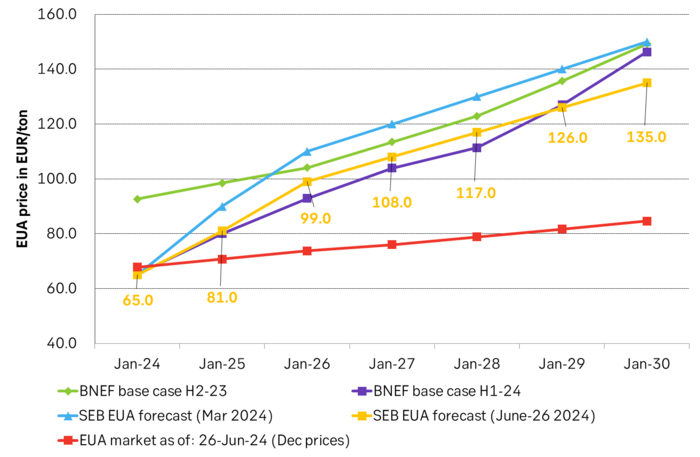
Analys
The most important data point in the global oil market will be published on Friday 28 June


US crude oil production has been booming for more than a decade. Interrupted by two setbacks in response to sharp price declines. The US boom has created large waves in the global oil market and made life very difficult for OPEC(+). Brent crude has not traded below USD 70/b since Dec-2021 and over the past year, it has averaged USD 84/b. US shale oil production would typically boom with such a price level historically. However, there has been zero growth in US crude oil production from Sep-2023 to Mar-2024. This may be partially due to a cold US winter, but something fundamentally seems to have changed. We recently visited a range of US E&P and oil services companies in Houston. The general view was that there would be zero growth in US crude oil production YoY to May 2025. If so and if it also is a general shift to sideways US crude oil production beyond that point, it will be a tremendous shift for the global oil market. It will massively improve the position of OPEC+. It will also sharply change our perception of the forever booming US shale oil supply. But ”the proof is in the pudding” and that is data. More specifically the US monthly, controlled oil production data is to be published on Friday 28 June.
The most important data point in the global oil market will be published on Friday 28 June. The US EIA will then publish its monthly revised and controlled oil production data for April. Following years of booming growth, the US crude oil production has now gone sideways from September 2023 to March 2024. Is this a temporary blip in the growth curve due to a hard and cold US winter or is it the early signs of a huge, fundamental shift where US crude oil production moves from a decade of booming growth to flat-lining horizontal production?
We recently visited a range of E&P and oil services companies in Houston. The general view there was that US crude oil production will be no higher in May 2025 than it is in May 2024. I.e. zero growth.
It may sound undramatic, but if it plays out it is a huge change for the global oil market. It will significantly strengthen the position of OPEC+ and its ability to steer the oil price to a suitable level of its choosing.
The data point on Friday will tell us more about whether the companies we met are correct in their assessment of non-growth in the coming 12 months or whether production growth will accelerate yet again following a slowdown during winter.
The US releases weekly estimates for its crude oil production but these are rough, temporary estimates. The market was fooled by these weekly numbers last year when the weekly numbers pointed to a steady production of around 12.2 m b/d from March to July while actual monthly data, with a substantial lag in publishing, showed that production was rising strongly.
The real data are the monthly, controlled data. These data will be the ”proof of the pudding” of whether US shale oil production now is about to shift from a decade of booming growth to instead flat-line sideways or whether it will drift gradually higher as projected by the US EIA in its latest Short-Term Energy Outlook.
US crude oil production given by weekly data and monthly data. Note that the monthly, controlled data comes with a significant lag. The market was thus navigating along the weekly data which showed ”sideways at 12.2 m b/d” for a significant period last year until actual data showed otherwise with a time-lag.
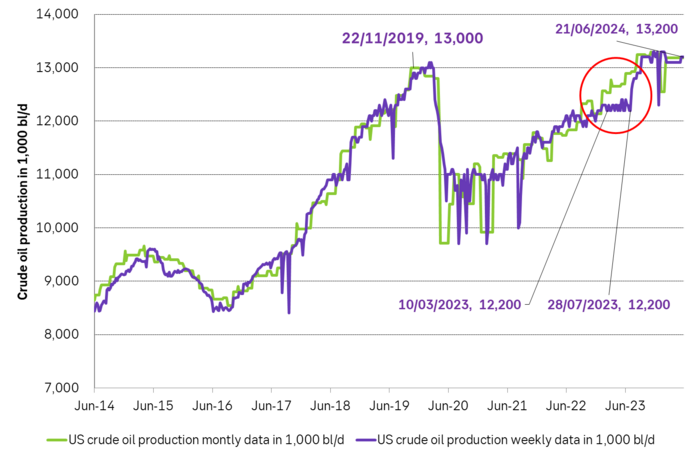
If we add in Natural Gas Liquids and zoom out to include history back to 2001 we see an almost uninterrupted boom in supply since Sep 2011 with a few setbacks. At first glance, this graph gives little support to a belief that US crude oil production now suddenly will go sideways. Simple extrapolation of the graph indicates growth, growth, growth.
US crude and liquids production has boomed since September 2011
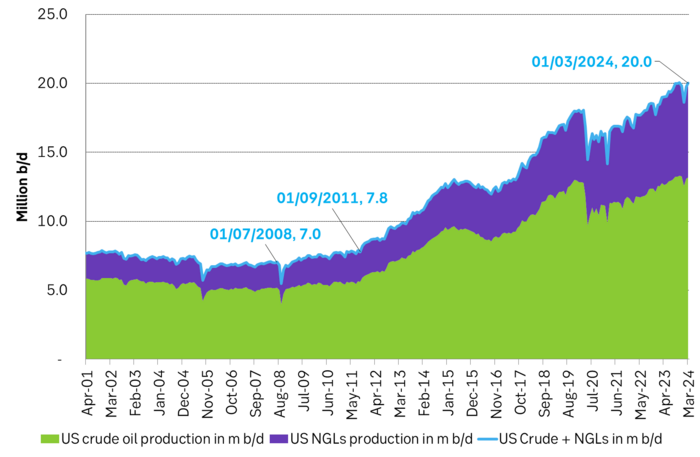
However. The latest actual data point for US crude oil production is for March with a reading of 13.18 m b/d. What stands out is that production then was still below the September level of 13.25 m b/d.
The world has gotten used to forever growing US crude oil production due to the US shale oil revolution, with shorter periods of sharp production declines as a result of sharp price declines.
But the Brent crude oil price hasn’t collapsed. Instead, it is trading solidly in the range of USD 70-80-90/b. The front-month Brent crude oil contract hasn’t closed below USD 70/b since December 2021.
Experiences from the last 15 years would imply wild production growth and activity in US shale oil production at current crude oil prices. But US crude oil production has now basically gone sideways to lower from September to March.
The big, big question is thus: Are we now witnessing the early innings of a big change in US shale oil production where we shift from booming growth to flat-lining of production?
If we zoom in we can see that US liquids production has flat-lined since September 2023. Is the flat-lining from Sep to Mar due to the cold winter so that we’ll see a revival into spring and summer or are we witnessing the early signs of a huge change in the global oil market where US crude oil production goes from booming growth to flat-line production.

The message from Houston was that there will be no growth in US crude oil production until May 2025. SEB recently visited oil and gas producers and services providers in Houston to take the pulse of the oil and gas business. Especially so the US shale oil and shale gas business. What we found was an unusually homogeneous view among the companies we met concerning both the state of the situation and the outlook. The sentiment was kind of peculiar. Everybody was making money and was kind of happy about that, but there was no enthusiasm as the growth and boom years were gone. The unanimous view was that US crude oil production would be no higher one year from now than it is today. I.e. flat-lining from here.
The arguments for flat-lining of US crude oil production here onward were many.
1) The shale oil business has ”grown up” and matured with a focus on profits rather than growth for the sake of growth.
2) Bankruptcies and M&As have consolidated the shale oil companies into larger, fewer public companies now accounting for up to 75% of total production. Investors in these companies have little interest/appetite for growth after having burned their fingers during a decade and a half of capital destruction. These investors may also be skeptical of the longevity of the US shale oil business. Better to fully utilize the current shale oil infrastructure steadily over the coming years and return profits to shareholders than to invest in yet more infrastructure capacity and growth.
3) The remaining 25% of shale oil producers which are in private hands have limited scope for growth as they lack pipeline capacity for bringing more crude oil from field to market. Associated nat gas production is also a problem/bottleneck as flaring is forbidden in many places and pipes to transport nat gas from field to market are limited.
4) The low-hanging fruits of volume productivity have been harvested. Drilling and fracking are now mostly running 24/7 and most new wells today are all ”long wells” of around 3 miles. So hard to shave off yet another day in terms of ”drilling yet faster” and the length of the wells has increasingly reached their natural optimal length.
5) The average ”rock quality” of wells drilled in the US in 2024 will be of slightly lower quality than in 2023 and 2025 will be slightly lower quality than 2024. That is not to say that the US, or more specifically the Permian basin, is quickly running out of shale oil resources. But this will be a slight headwind. There is also an increasing insight into the fact that US shale oil resources are indeed finite and that it is now time to harvest values over the coming 5-10 years. One company we met in Houston argued that US shale oil production would now move sideways for 6-7 years and then overall production decline would set in.
The US shale oil revolution can be divided into three main phases. Each phase is probably equally revolutionary as the other in terms of impact on the global oil market.
1) The boom phase. It started after 2008 but didn’t accelerate in force before the ”Arab Spring” erupted and drove the oil price to USD 110/b from 2011 to 2014. It was talked down time and time again, but it continued to boom and re-boom to the point that today it is almost impossible to envision that it won’t just continue to boom or at least grow forever.
2) The plateau phase. The low-hanging fruits of productivity growth have been harvested. The highest quality resources have been utilized. The halfway point of resources has been extracted. Consolidation, normalization, and maturity of the business has been reached. Production goes sideways.
3) The decline phase. Eventually, the resources will have been extracted to the point that production unavoidably starts to decline.
Moving from phase one to phase two may be almost as shocking for the oil market as the experience of phase 1. The discussions we had with oil producers and services companies in Houston may indicate that we may now be moving from phase one to phase two. That there will be zero shale oil production growth YoY in 2025 and that production then may go sideways for 6-7 years before phase three sets in.
US EIA June STEO report with EIA’s projection for US crude oil production to Dec-2025. Softer growth, but still growth.
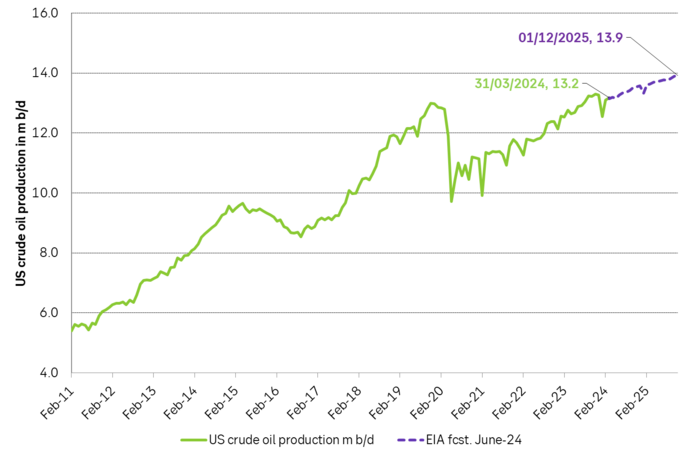
US EIA June STEO report with YoY outlook growth for 2025. Projects that US crude production will grow by 0.47 m b/d YoY in 2025 and that total liquids will grow by 720 k b/d YoY.
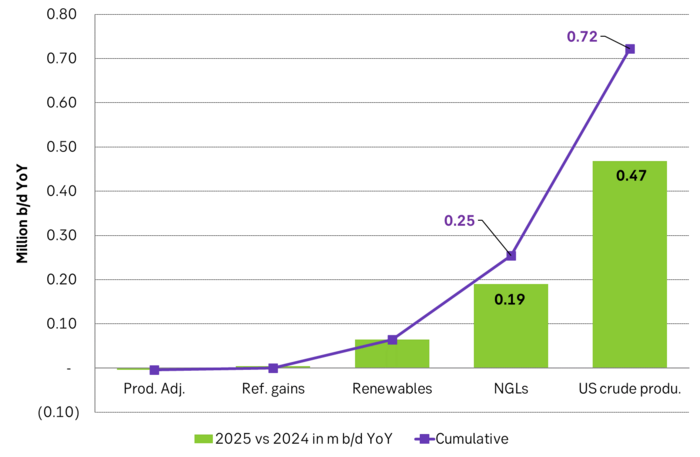
US EIA June STEO report with outlook for production growth by country in 2025. This shows how big the US production growth of 0.7 m b/d YoY really is compared to other producers around the world
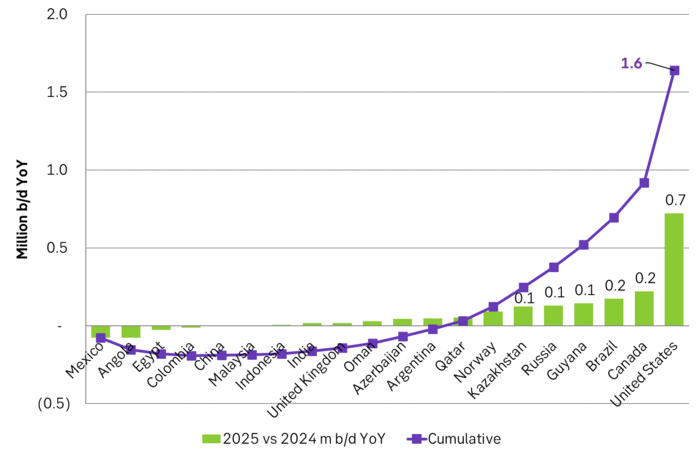
US EIA June STEO report with projected global growth in supply and demand YoY in 2025. Solid demand growth, but even strong supply growth with little room for OPEC+ to expand. Production growth by non-OPEC+ will basically cover global oil demand growth.
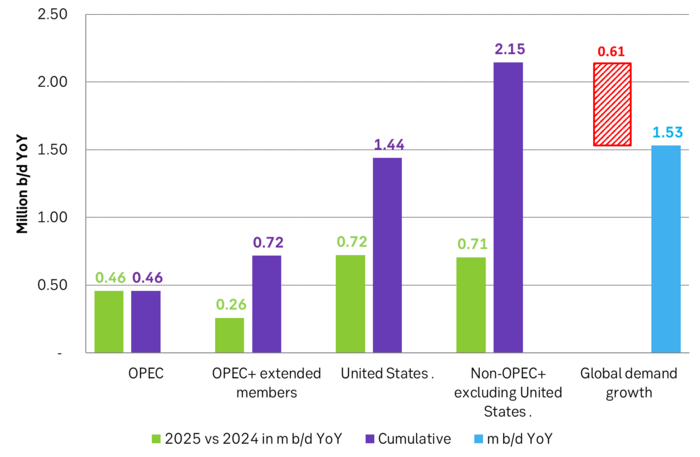
But if there instead is zero growth in US crude oil production in 2025 and the US liquids production only grows by 0.25 m b/d YoY due to NGLs and biofuels, then suddenly there is room for OPEC+ to put some of its current production cuts back into the market. Thus growth/no-growth in US shale oil production will be of huge importance for OPEC+ in 2025. If there is no growth in US shale oil then OPEC+ will have a much better position to control the oil price to where it wants it.
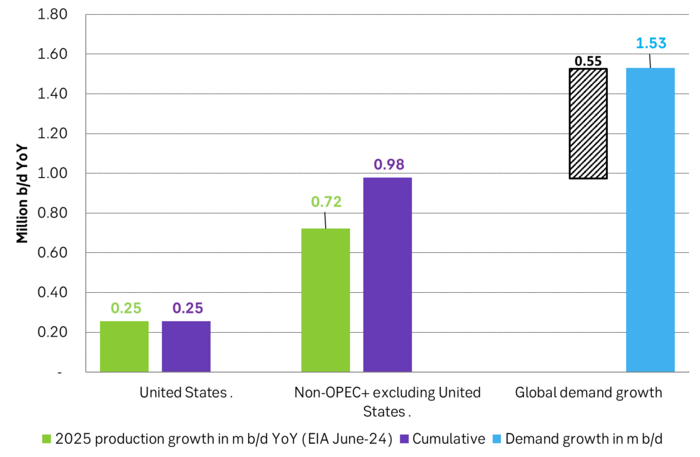
US crude oil production and drilling rig count
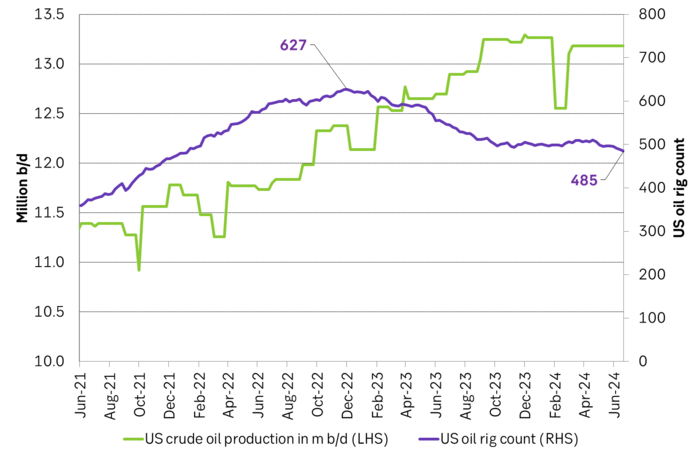
-

 Nyheter7 dagar sedan
Nyheter7 dagar sedanDe tre bästa råvaruvaruaktierna just nu
-

 Nyheter2 veckor sedan
Nyheter2 veckor sedanLundin Mining vill köpa Filo Corp tillsammans med BHP
-

 Nyheter4 veckor sedan
Nyheter4 veckor sedanAfrica Oil är bra att köpa anser Stifel som inleder analysbevakning
-
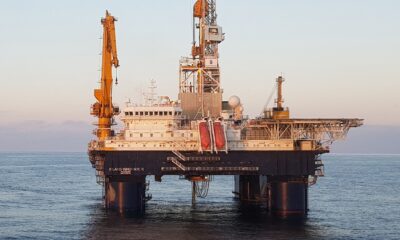
 Nyheter3 veckor sedan
Nyheter3 veckor sedanStor risk att Africa Energy inte överlever det kommande året
-

 Nyheter4 veckor sedan
Nyheter4 veckor sedanFirst Nordic Metals har fyra prospekteringsprojekt i Sverige
-

 Analys4 veckor sedan
Analys4 veckor sedanBrent crude inching higher on optimism that US inflationary pressures are fading
-

 Nyheter2 veckor sedan
Nyheter2 veckor sedanUniper satsar på att göra elektrobränsle av sin elektricitet
-

 Nyheter2 veckor sedan
Nyheter2 veckor sedanTre bra aktier inom olja och oljeservice i Kanada


